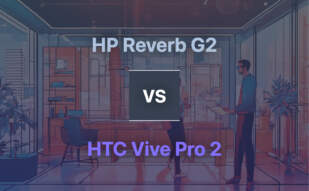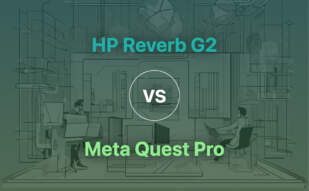Pimax Crystal offers an ultra-clear VR headset with glass aspheric lenses and top-notch features like Pixels-Per-Degree (PPD) of 35 and high-quality eye tracking at 120 Hz. Equipped with two VR modes, customizable lenses, and a hardware setup for a premium VR experience.
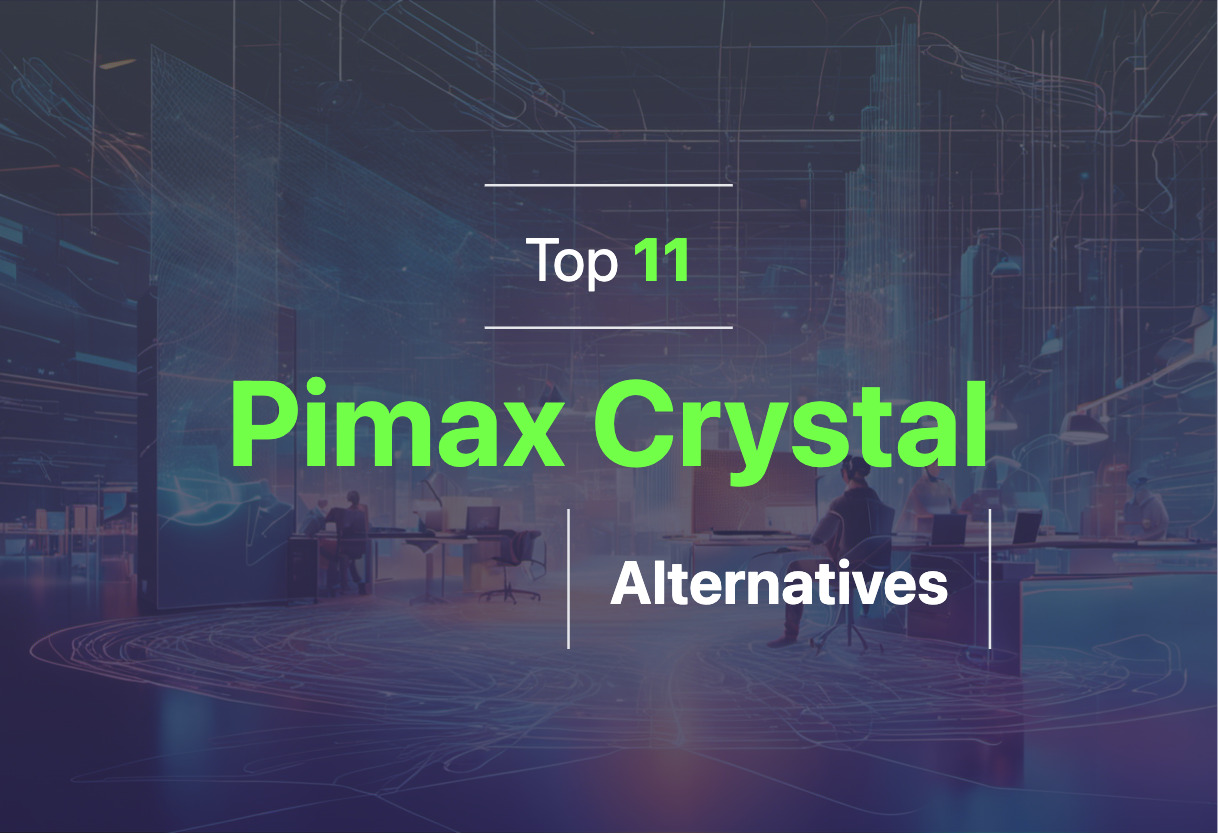
Looking for alternatives to Pimax Crystal? Consider Reverb G2, Valve Index, Vive Pro 2, Vive, PSVR 2, Quest Pro, Quest 2, Rift S, and more for your VR adventures.
Reverb G2
Brought to you by the tech powerhouse, HP, the Reverb G2 is a formidable face-off within the Virtual Reality jungle. Tailored for Microsoft’s Windows Mixed Reality platform, it promises an immersive experience without draining your wallet completely.
Reverb G2 Top Features
- Improved comfort with memory foam-lined facemask that’s easily washable
- External cameras for motion tracking – No need for separate sensors or beacons!
- Visor slider for adjusting pupillary distance – No more VR sickness!
- Super crispy display of 2160 by 2160 pixels at 90Hz – Allows you to capture every detail
- Compatibility with SteamVR and Windows Mixed Reality making it versatile
| Resolution | 2160 x 2160 (per eye) |
| Refresh Rate | 90Hz |
| Motion Controllers | Yes (Two included) |
Reverb G2 Downsides
- May encounter some hitches in camera-based motion tracking
- Slight chance of losing track of controller movements
- May face interface issues with Windows Mixed Reality platform
- Despite the mixed reality promise, a powerful PC is required
Reverb G2 Pricing
Price-smart, the Reverb G2 sells for $599.99, giving the HTC Vive Pro 2 ($799) and the Valve Index ($999) a run for their money. However, bear in mind, it’s pricier than the standalone Oculus Quest 2 at $299.99.
Reverb G2 Use Cases
Gaming
With crisp visuals and immersive headset experience, the Reverb G2 enriches your gaming expeditions. Get a real-life feel of being on the driver’s seat in Project CARS Pagani Edition or socialize in virtual spaces with VRChat.
Professional Training
Improve your aim with Aim Lab VR, or discover physics with Nvidia VR Funhouse. With Reverb G2’s sharp imagery and immersive audio, professional training could not get more real!
Development
Leverage the compatibility with SteamVR to develop and experience groundbreaking VR applications. Plug a Reverb G2 to your powerful workstation, and the mixed reality world is your playground!
Valve Index

Launched by tech giant Valve, the Valve Index is a second-generation, consumer-friendly virtual reality headset that entered the VR landscape on June 28, 2019.
Valve Index Top Features
- Dual RGB LCD Displays: Embellished with dual 1440 x 1600 RGB LCDs, offering 50% more subpixels than OLED for better sharpness.
- Adjustable Frame Rates: With versatility at its core, it offers adjustable frame rates – 80/90/120/144Hz, enhancing optical comfort for extended play sessions.
- Expanded Field of View: Equipped with fine-tuned lenses that boost the Field of View (FOV), giving an extra 20 degrees compared to HTC Vive, customizable optics.
| Audio Features | Boasts of an innovative off-ear audio solution, offering adjustable speaker positioning and ultra-nearfield flat panel speakers. |
| Ergonomics | Built for maximum user comfort with antimicrobial fabric used in contact surfaces and accommodates adjustments for head size, face angle, eye relief, and IPD. |
| Controllers | Armed with 87 sensors that monitor hand and finger positions; an array of controls including a joystick, touchpad, two face buttons, a menu button, and a trigger. |
Valve Index Limitations
- Price: With an outlay of $799 for the headset alone and $999 for the full kit, it stands as a costly option.
- Absence of Eye Tracking: One of its significant drawbacks is the lack of eye tracking technology.
- Room-scale Sensor Setup: The platform has a complicated room-scale sensor setup, which can prove frustrating for users.
Valve Index Pricing
Valve Index is available for purchase at $799 for the headset and you can avail of the full kit, which includes the headset, controllers, and base stations, for $999.
Valve Index Use Cases
Use case 1 (Gaming)
The Valve Index, with its advanced frame rates and an expanded field of view, provides an enhanced gaming experience, particularly for extended play sessions.
Use case 2 (Immersion)
The ergonomics and adjustable optics of the Valve Index make it a commendable option for users seeking deep immersion experiences in a VR environment.
Use case 3 (Professional Training)
With its sophisticated hand and finger position tracking, the Valve Index can be effectively utilized for professional training sessions in virtual settings.
Quest 3
Meta Quest 3 is a game-changer in the world of mixed reality, marking a first for mass-market headsets. With a marked increase in visual resolution and audio range from its predecessor, it pushes the boundary of immersive experiences.
Quest 3 Top Features
- Powered by Snapdragon XR2 Gen 2, providing twice the graphic processing power of Quest 2.
- 4K+ Infinite Display offering a 30% leap in resolution compared to Meta Quest 2.
- Redesigned, thinner profile with a softer, adjustable strap design.
- Enhanced sound clarity and 40% louder audio range than its precursor.
- New depth sensor and updated cameras for automatic guardian system and spatial data.
| Graphics | Powered by double graphic processing power of Quest 2 with Snapdragon XR2 Gen 2 |
| Resolution | 4K+ Infinite Display; 30% leap in resolution compared to Meta Quest 2 |
| Audio range | 40% louder than the Quest 2 |
Quest 3 Downsides
While the Quest 3 holds a lot of enticing features, it’s not without its limitations.
- Price: While the advanced features justify the cost, it’s important to note that it may not fit everyone’s budget.
- Big Leap: Its huge leap in technology might require new users to have a learning curve.
Quest 3 Pricing
Quest 3 is available in two models: 128GB for $499.99, and 512GB for $649.99. Pre-orders are currently open and early buyers are offered a free game and a six-month subscription to Meta Quest Plus.
Quest 3 Use Cases
Use Case 1: Gaming
With the Quest 3, you can fully immerse yourself in the world of mixed reality gaming. Its advanced features bring a whole new level of realism to games like Demeo and Dungeons of Eternity.
Use Case 2: Fitness
With its innovative mixed reality capabilities, the Quest 3 provides an all-new platform for fitness training, offering an experience like never before with Xponential+.
Use Case 3: Sports Viewing
Avid sports fans can enjoy watching their favorite games in a whole new perspective with Xtadium, giving live sports events a virtual, interactive twist.
Vive Pro 2
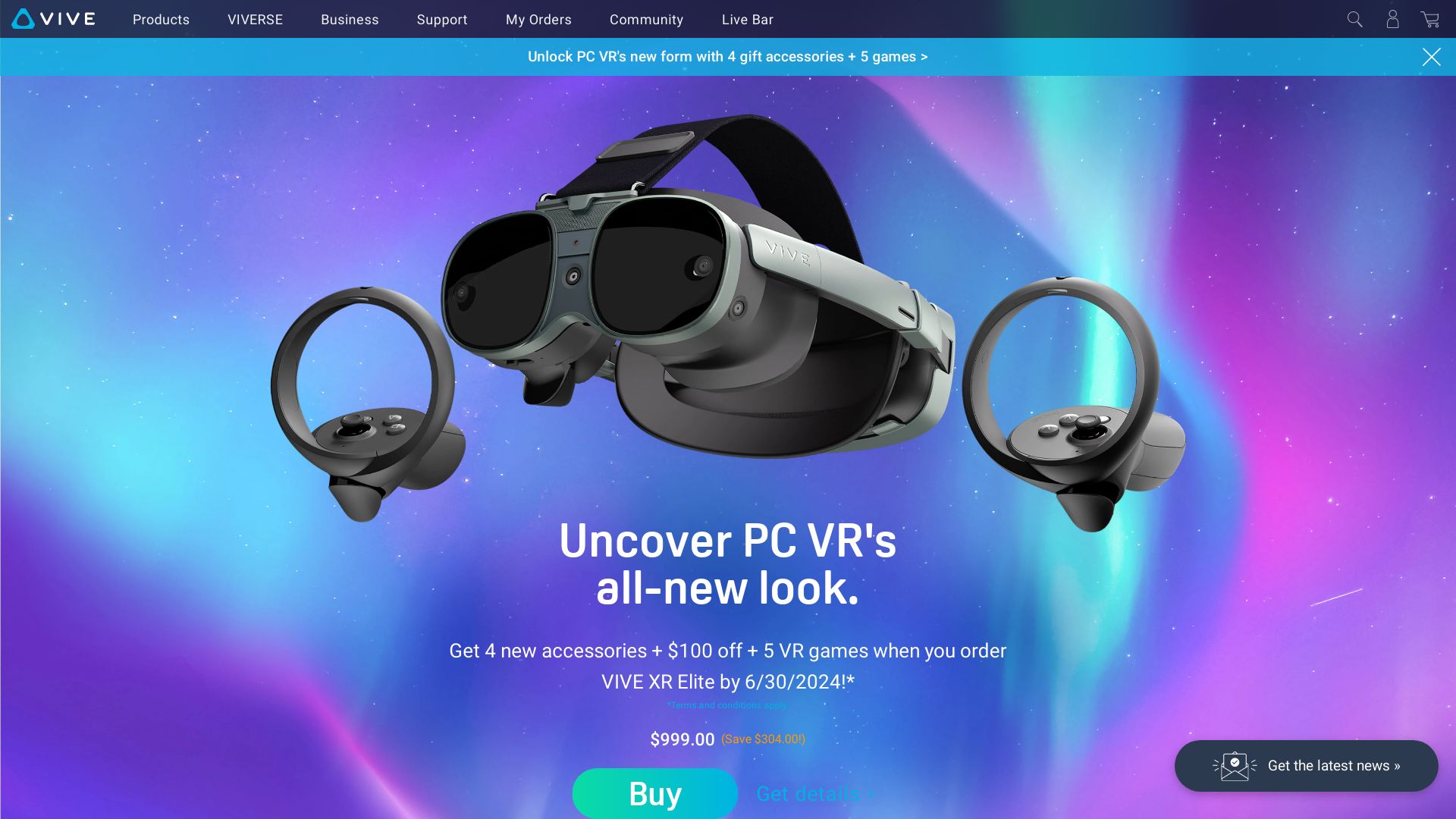
Take a deep breath and dive into the realm of Augmented Reality with the Vive Pro 2. Crafted for sharp, precise and immersive AR/VR experience, this beast comes armed with a 2-month Viveport Infinity membership and is teamed up with three.js, the indomitable cross-browser JavaScript library.
Top Features of Vive Pro 2
- Impressive, high-end AR/VR headset
- Comes with a 2-month Viveport Infinity membership
- Powerful connection with three.js, a popular Javascript animation library
- Frees you from the shackles of proprietary browser plugins
- Active community support with over 1700 contributors on GitHub
- Provides manifold features like anaglyph, cross-eyed, parallax barrier effects
| Programming Partner | Developed In |
|---|---|
| Three.js | JavaScript |
| GB Repository | 1700+ contributors |
Limitations of Vive Pro 2
- API documentation still under construction
Pricing of Vive Pro 2
Bring out your rebellious side with Vive Pro 2, pricing details of which are yet to be released. Until then, enjoy the wild, free world of AR/VR.
Vive Pro 2 Use Cases
Use Case 1: Game Developers
The accessibility and flexibility of Vive Pro 2 make it a godsend for game developers aiming to weave intricate 3D animations into their gameplay.
Use Case 2: Educational Institutions
With its immersive AR/VR capabilities, Vive Pro 2 can be a revolutionary tool for educational institutions, offering unparalleled learning experiences for students.
Use Case 3: Industrial Design
For industries involved in complex design processes, Vive Pro 2’s precise and comprehensive 3D modeling capabilities make it a force to reckon with.
Vive
Your quest for a premium VR experience ends here. Meet Vive, a pioneering force in the realm of Virtual Reality, developed by giants Valve and HTC. FSMcEarly for a launch in April, Vive is powered by high-resolution screens and boasts graphics that will push the boundaries of your sensory realms.
Vive Top Features
- High-end, high-resolution screens for a full-blown VR adventure
- Unique freedom of movement within a 15 x 15-foot room facilitated by a state-of-the-art laser tracking system
- Enhanced gaming experience with attached motion controllers
- Access to HTC Vive’s impressive content library
- High-resolution 5K screens, promising a wide field of view at 120 degrees
- Designed for room-scale tracking, paired optimally with Valve Index Controllers
| Features | Benefits |
|---|---|
| Vive Pro 2 | Dubbed as an upgrade, it sports the highest resolution screen in the VR realm |
| Compatibility with Valve Index Controllers | Ensures a seamless blend of comfort and accurate tracking |
| On-ear headphones included | Ensures optimum gaming experience, can be replaced with USB-C headphones for even better sound |
Vive Disadvantages
- Price point of around $799, not including potential additional cost around $1,000 for VR-ready PC
- Conventional wand-style controllers might feel awkward for some
- Demanding in terms of system requirements
Vive Pricing
The Vive headset is expected to be priced around a chunky $799, prior to its launch. Keep in mind, to optimize the Vive experience, you’ll need a VR-ready PC that could add approximately $1000 more to your expenses.
Vive Use Cases
Use case 1
If you’re a devoted gamer, Vive can catapult you into a whole new dimension of immersive gaming. Its advanced features including motion tracking and a vast content library, including the likes of Half-Life: Alyx and Beat Saber, make it an enviable choice for the gaming community.
Use case 2
For companies in the architecture, design, or real estate sectors, Vive can be a brilliant tool to showcase intricate designs or property walk-throughs to clients, providing a uniquely interactive experience.
Use case 3
Trainers and educators can utilize Vive’s interactive VR environment for innovative training sessions and simulations, offering students or trainees a hands-on learning experience that goes beyond the traditional methods of teaching.
PSVR 2
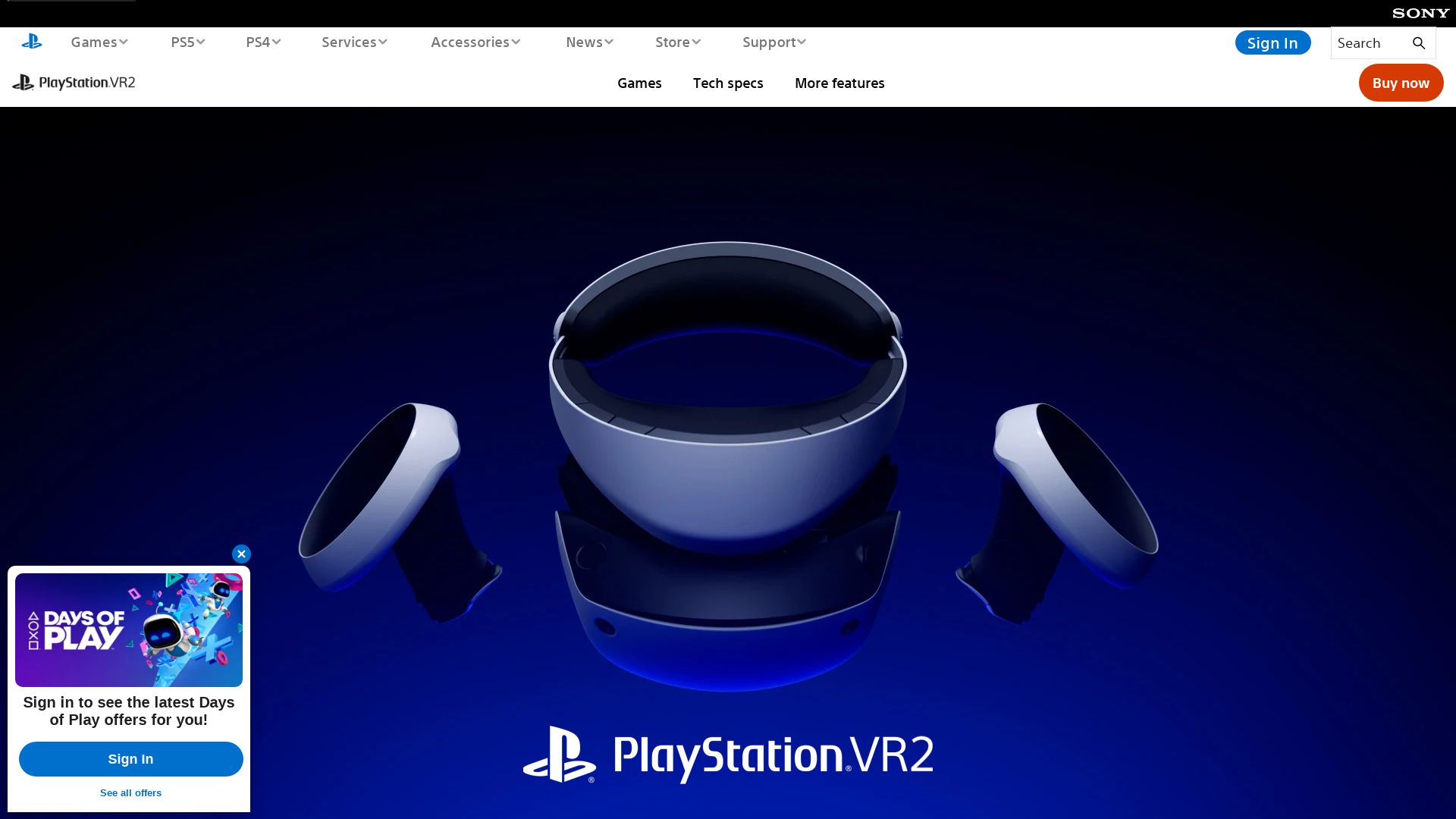
An evolution in the realm of VR, the PSVR 2 comes equipped with a plethora of benefits, albeit with its own sets of limitations. Requiring a PlayStation 5 for usage, it outperforms its predecessor, PSVR 1, on multiple fronts while being superior to rivals like the Meta Quest 2.
Top Features of PSVR 2
- Cutting-edge Specs: With a resolution upgrade from 960 x 1,080 to 2,000 x 2,040, the PSVR 2 ensures top-tier performance.
- Eye-Tracking: Tracks eye movements within the headset, thereby elevating the immersive experience.
- Advanced Controllers: Upgrades from the old Move controllers to the new Sense controllers, considerably enhancing in-game control.
- Higher Comfort Level: Despite being bulky, it isn’t heavy and comes with a sturdy headband and adjustable lenses.
| Additional Features | Value |
|---|---|
| Supports HDR | Yes |
| Field of View | Approx. 110 Degrees |
| Refresh Rate | up to 120Hz |
Limitations of PSVR 2
- High Cost: With a price tag of $550, it is more costly than even the console required for its usage.
- Non-Compatible with Previous Titles: Users cannot enjoy games from the previous PSVR model, restricting content availability.
- Battery Life Issues: Batteries run out swiftly, posing potential interruptions in the VR experience.
PSVR 2 Pricing
The PSVR 2 enters the market at a hefty cost of $549.99, a price point that goes beyond the cost of the PS5. This may limit its reach to the more budget-conscious VR enthusiasts, who may be seeking something more affordable.
PSVR 2 Use Cases
Use Case 1: Gaming Enthusiasts
With a vivid display, high performance, and immersive gaming experience, it’s an ideal choice for gaming aficionados seeking next-generation VR gaming.
Use Case 2: Multimedia Consumers
The HDR support, high resolution, and inside-out tracking make the PSVR 2 a solid choice for those seeking a quality VR media consumption experience.
Use Case 3: Future-proof VR Users
The PSVR 2, with future VR exclusive titles and robust Sense controllers, offers a viable option for users seeking a long-term investment.
Quest Pro
Immerse yourself in the next-generation VR/AR experience with Quest Pro, an advanced headset designed by Meta, innovated especially for all those professional needs.
Top Features of Quest Pro
- Snapdragon XR2+ processor: 50% stronger than Quest 2, ensuring a smoother, faster experience.
- Design: A sleek, black, glossy finish delivering a professional look with comfort.
- Features five cameras (3 front-facing and 2 side-facing) for a comprehensive view.
- Inclusive of a charging cradle, with a USB-C port, cable, wall adapter included, and protective rubber cap.
- Resolution: Offering 1,920 x 1,800 pixels per eye, a local dimming backlight system, and a 130% larger color gamut than Quest 2.
- Boasts an eye tracking calibration and face tracking for a refined VR/AR experience.
| Memory | Storage | Cost |
|---|---|---|
| 12GB RAM | 256GB | $1499.99 |
Downsides of Quest Pro
- Unpadded headset may cause discomfort against the face.
- Peripheral vision is exposed leading to potential distraction.
- High cost may not suit all consumers, particular catered towards professionals.
- Limited consumer-focused software leveraging Quest Pro upgrades.
Quest Pro Pricing
Quest Pro, packed with powerful features and capabilities, has a cost of $1499.99, making it a high-end device for professionals.
Quest Pro Use Cases
Use Case 1: Enterprise Solutions
Quest Pro’s powerful Snapdragon XR2+ processor, intuitive motion controls, and high-resolution display make it ideal for enterprise users. Professionals from diverse sectors can leverage the headset for workflow integration and collaborative work through customized interfaces.
Use Case 2: Gaming & Entertainment
With a significant performance boost and enhanced tracking system, the Quest Pro delivers an immersive gaming and entertainment experience for mature-rated apps and more.
Use Case 3: Education & Training
Quest Pro’s extended features like ‘Standby Mode’, ‘Contact Posters’, ‘Check In’ within Messages facilitates innovative ways for education and training modules delivery, bridging the virtual and real world.
Quest 2
Manufactured by the innovative division at Meta Platforms, Reality Labs, the Quest 2, initially known as Oculus Quest 2, is a competitive VR headset that entered the market on October 13, 2020. Over time the product transcended from Oculus to Meta as part of an overall Meta transition.
Quest 2 Top Features
- Empowered by Qualcomm SnapDragon XR2 processor.
- Generously equipped with 6 GB LPDDR4X memory and various storage options of 64GB (discontinued), 128GB, and 256GB.
- Adorned with a vibrant RGB LCD display providing 1832 x 1920 resolution per eye and up to a 120Hz refresh rate.
- Advanced 6DOF inside-out tracking carried out by four built-in cameras and two controllers.
- Offered USB-C, Bluetooth 5, and Wi-Fi 6 for brisk connectivity.
| Design | A lightweight form with high spec updates and an enhanced display. |
| Online Services | Caters the Quest Store with a plethora of VR games and experiences. |
| Meta Account Support | The platform is accessible for those aged 10+, majorly favoring Quest 2 and 3 users. |
Quest 2 Limitations
- Originally provided a 64GB storage that was expanded to a standard 128GB, yet no options for further expansion.
- Battery life is a letdown with a maximum capacity of 2-3 hours per charge.
- The display upgrade was impressive, but the battery efficiency stayed constant through the transition.
Quest 2 Pricing
The Quest 2 is available at market prices of $299 for its 64 GB variant and $399 for the 256 GB model.
Quest 2 Use Cases
Use case 1
Boasting detailed visuals and a high refresh rate, Quest 2 is ideal for gamers demanding top-tier graphical fidelity and smooth performance.
Use case 2
With its Android-based Quest system software and high specs, it’s a fitting choice for developers aiming to build immersive VR applications.
Use case 3
Endowed with a lightweight design and easy to use features, the Quest 2 works well for VR novices for an introduction into the VR realm.
Rift S
Developed by Facebook Technologies and Lenovo, Rift S is an improved successor to the original Oculus Rift. Launched in March 2019, it was designed for gamers who crave an immersive virtual reality experience with better high-end game compatibility and ease of setup.
Top Features of Rift S
- Oculus Insight tracking tech: This tech ensures precision and immersion in gaming experiences.
- 5 integrated cameras: Positioned strategically for accurate room-scale tracking, there’s no need for external sensors.
- Next-gen lens technology: Designed to eliminate god rays, enhancing display clarity.
- Showcased Compatibility: Compatible with Oculus Store, Viveport store, and Steam VR.
- Passthrough+ Feature: Ensures safety by showing monochrome surroundings when users step outside their designated boundary.
- Redesigned Oculus Touch controllers optimized for inside-out tracking.
| Feature | Description |
|---|---|
| Display | Offers a resolution of 2560×1440 (1280×1440 per eye) alongside an 80Hz refresh rate for smooth gameplay. |
| Sound | Integrated speakers and a 3.5mm stereo headphone jack give audio options to the user. |
| Comfort | Lenovo-designed halo headband optimizes weight distribution for long gameplay sessions. |
Rift S Limitations
- Only Incremental Upgrade: Despite improvements over the original Oculus Rift, users have pointed out that Rift S is not a significant upgrade.
- Software-adjustable IPD: IPD adjustment mechanism is software-based and can only go as low as 61.5mm or as high as 65.5mm.
- Discontinued Production: Rift S ceased production in June 2021, potentially affecting aftermarket support and updates.
Rift S Pricing
At its launch, Rift S was priced at $399, delivering high-quality features at an affordable price point.
Rift S Use Cases
Use Case 1: Gaming
Rift S, with better game compatibility and accurate room-scale tracking, is ideal for gamers seeking advanced and immersive VR experiences.
Use Case 2: VR Enthusiasts
Offering improvements like enhanced image clarity and the “Insight” tracking system, the Rift S is a great choice for VR enthusiasts who cherish quality and precision.
Use Case 3: VR Developers
Rift S offers a great platform for developers looking to create, test, and deploy next-generation VR experiences thanks to its compatibility with major VR stores.
HP Omnicept
Pushing the boundaries of enterprise VR headset technology is the HP Omnicept. This trailblazing headset integrates advanced sensors that track eye, mouth, and heartbeat movements, offering heightened sensitivity and new levels of immersion.
HP Omnicept Key Features
- Superior resolution with 2160×2160 pixels per eye and a refresh rate of 90Hz.
- Advanced biometric tracking with sensors for eye, mouth, and heartbeat movement.
- Omnicept software layer designed to integrate and interpret sensor data.
- Impressive audio-visual capabilities including off-ear headphones and pass-through cameras, and an integrated microphone.
- Omnicept headset features both USB-C and DisplayPort connectors with a 6-meter cable for expansive movement.
- Optimal data protection, with no data stored on the headset and compliance to GDPR regulations.
- Unique features like 3D spatial audio, adjustable lenses, and real-time facial animation.
| Features | Benefits |
|---|---|
| Omnicept SDK | Facilitates enterprise solution development |
| Improved strap tightening mechanism | Enhances user experience and headset stability |
| Camera for mouth movement capture | Sustains animation of virtual avatars |
HP Omnicept Limitations
- Given its advanced features, HP Omnicept may come with a steep learning curve for beginners.
- Its focus on enterprise solutions may not fully cater to all consumer needs.
- The cost of software deployment along with one-time licenses could be a potential downside for smaller businesses.
HP Omnicept Pricing
HP Omnicept is currently projected for release in May, with a launch price set at $1,250. This includes a one-time license for in-house solutions. For those creating solutions for sale to enterprise customers, HP offers a revenue-share model.
HP Omnicept Use Cases
Use case 1: Enterprise Training
With an impressive resolution of 2160×2160 pixels per eye and a high refresh rate of 90Hz, HP Omnicept is perfect for delivering highly immersive, interactive training experiences in enterprise settings.
Use case 2: Virtual Collaboration
Omnicept’s unique ability to capture mouth movements and animate virtual avatars allows for real-time interaction, making it a powerful tool for virtual teamwork and collaboration.
Use case 3: Advanced Data Analysis
With GDPR compliant data tracking, the Omnicept can be used by data scientists and analysts to understand cognitive load in various scenarios, paving the way for smarter, data-driven solutions.
Pico 4
The Pico 4 is a Virtual Reality headset launched in 2022 by ByteDance. Primed for a vivid and immersive VR experience, this device is a small size with a big impact.
Pico 4 Top Features
- Balance and Comfort: The design emphasizes ergonomics and distributes weight evenly for optimal user comfort.
- Pancake lenses: These lenses contribute to weight and volume reduction while improving image quality and avoiding glare effects.
- Immersive Experience: Features 2 Fast-LCD displays with over 2K resolution per eye, offering a field of view of 105°. Also incorporates 360° stereo speakers with 3D spatial sound.
| Processing Power | Features Qualcomm Snapdragon XR2 and 8GB LPDDR4 RAM. Also offers an enterprise variant with LPDDR5 RAM for businesses. |
| Automatic Interpupillary Distance Adjustment | Motorized adjustment in Pico 4 and Enterprise for ease of use. |
| Haptic Motion Controllers | Offer realistic tactile feedback enhancing the immersive experience. |
Pico 4 Limitations
- Limited game library.
- Smaller field of view due to Pancake lenses.
Pico 4 Pricing
The Pico 4 headset is available for purchase at €429 on Amazon and XRshop.
Pico 4 Use Cases
Use case 1
The Pico 4’s ergonomic design and comfort make it ideal for long gameplay or entertainment sessions.
Use case 2
With its enterprise variant, the Pico 4 can be effectively used for business meetings or professional applications effectively.
Use case 3
The Pancake lenses and high resolution make it an excellent choice for graphic designers or other professionals requiring a superior visual experience.
Grant Sullivan
Content writer @ Aircada and self proclaimed board game strategist by day, AI developer by night.




